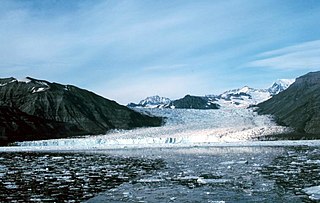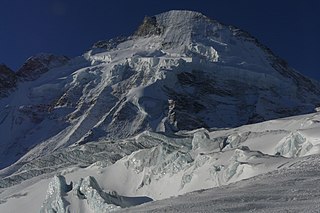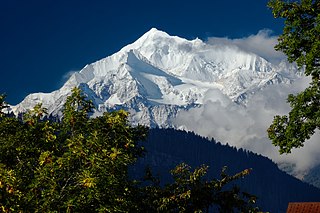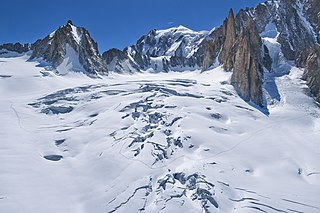
James David Forbes (1809–1868) was a Scottish physicist and glaciologist who worked extensively on the conduction of heat and seismology. Forbes was a resident of Edinburgh for most of his life, educated at its University and a professor there from 1833 until he became principal of the United College of St Andrews in 1859.

John Tyndall (; 2 August 1820 – 4 December 1893) was a prominent 19th-century Irish physicist. His scientific fame arose in the 1850s from his study of diamagnetism. Later he made discoveries in the realms of infrared radiation and the physical properties of air, proving the connection between atmospheric CO2 and what is now known as the greenhouse effect in 1859.

The Mer de Glace is a valley glacier located on the northern slopes of the Mont Blanc massif, in the French Alps. It is 7.5 km long and 200 metres (660 ft) deep but, when all its tributary glaciers are taken into account, it can be regarded as the longest and largest glacier in France, and the second longest in the Alps after the Aletsch Glacier.
I can no otherwise convey to you an image of this body of ice, broken into irregular ridges and deep chasms than by comparing it to waves instantaneously frozen in the midst of a violent storm.

Mount Saint Elias, the second-highest mountain in both Canada and the United States, stands on the Yukon and Alaska border about 26 miles (42 km) southwest of Mount Logan, the highest mountain in Canada. The Canadian side of Mount Saint Elias forms part of Kluane National Park and Reserve, while the U.S. side of the mountain is located within Wrangell-St. Elias National Park and Preserve.
Tyndall is the name of an English family taken from the land they held as tenants in chief of the Kings of England and Scotland in the 11th, 12th and 13th centuries.

Guyot Glacier is a 34-mile (55 km) long and 8-mile (13 km) wide glacier located in the east end of the Robinson Mountains in the U.S. state of Alaska. It begins 5.6 mi (9.0 km) north of Yaga Peak and heads east-southeast to Icy Bay, south of the Guyot Hills and 73 miles (117 km) northwest of Yakutat. It borders Yahtse Glacier on the northeast. The glacier was named by the New York Times expedition of 1886 for Arnold Henry Guyot.
Mount Tyndall is a mountain that is part of the Tyndall Range, a spur off the West Coast Range, located in the Western region of Tasmania, Australia.

The Dent d'Hérens is a mountain in the Pennine Alps, lying on the border between Italy and Switzerland. The mountain lies a few kilometres west of the Matterhorn.

The Tyndall Centre for Climate Change Research is an organisation based in the United Kingdom that brings together scientists, economists, engineers and social scientists to "research, assess and communicate from a distinct trans-disciplinary perspective, the options to mitigate, and the necessities to adapt to current climate change and continuing global warming, and to integrate these into the global, UK and local contexts of sustainable development".

Icy Bay is a body of water in the borough of Yakutat, Alaska, formed in the last 100 years by the rapid retreat of the Guyot, Yahtse, and Tyndall Glaciers. It is part of the Wrangell-Saint Elias Wilderness.
The Naro Moru River starts on Mount Kenya and flows down to the west, through Nyeri County, Kenya, into the Ewaso Ng'iro River. The North and South Naro Moru Rivers are fed by the Teleki Tarn, Lewis Glacier, Tyndall Tarn and Glacier, Hut Tarn and Darwin Glacier at the peaks of Mount Kenya. They join at 2,810 m (9,200 ft) above sea level. The Naro Moru River flows for around 50 km (31 mi), through Naro Moru town, until it reaches the Ewaso Ngiro River. The catchment area of the Naro Moru River is around 83 km2.

The Weisshorn is a major peak of Switzerland and the Alps, culminating at 4,505 metres above sea level. It is part of the Pennine Alps and is located between the valleys of Anniviers and Zermatt in the canton of Valais. In the latter valley, the Weisshorn is one of the many 4000ers surrounding Zermatt, with Monte Rosa and the Matterhorn.

Tyndall Glacier is a small cirque glacier in Rocky Mountain National Park in the U.S. state of Colorado. Tyndall Glacier is on the east side of the Continental Divide and in a cirque to the north of Hallett Peak. Tyndall Glacier is both an ice and a rock glacier, with the lower portions of the glacier being composed primarily of rock debris and a small portion of ice.
Tyndall Glacier may refer to:
The Tyndall Mountains are a group of mountains close south of Avsyuk Glacier in central Arrowsmith Peninsula, Graham Land. Photographed from the air by FIDASE, 1956–57. Mapped by Falkland Islands Dependencies Survey (FIDS) from surveys and air photos, 1948–59. Named by United Kingdom Antarctic Place-Names Committee (UK-APC) for John Tyndall (1820–93), Irish mountaineer and pioneer glaciologist, author of many works on glaciers and the physical properties of ice.
Saussure Glacier is a glacier flowing northeast from Tyndall Mountains, Arrowsmith Peninsula, into Lallemand Fjord, Loubet Coast. Photographed from the air by Falkland Islands and Dependencies Aerial Survey Expedition (FIDASE) in 1957. Named by the United Kingdom Antarctic Place-Names Committee (UK-APC) in association with the names of glaciologists grouped in the area after Horace-Bénédict de Saussure (1740–99), Genevan naturalist and physicist, who in 1787 was the first to recognize that erratic boulders had been moved great distances by ice.

The Géant Glacier is a large glacier on the French side of the Mont Blanc massif in the Alps. It is the main supplier of ice to the Mer de Glace which flows down towards Montenvers. It gets its name from the nearby Dent du Géant.

Tyndall Glacier is a valley/tidewater glacier in the U.S. state of Alaska. The glacier lies immediately west of 141° West longitude, within the boundaries of the Wrangell–Saint Elias Wilderness, itself part of Wrangell–St. Elias National Park & Preserve, in the borough of Yakutat, Alaska.












